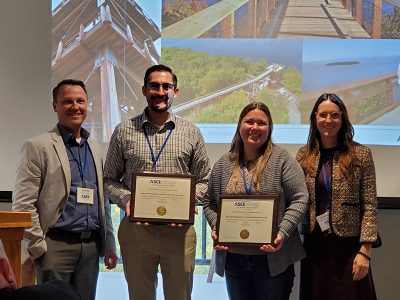Ayres-Designed Eagle Tower Wins ASCE Wisconsin Award
The innovative, Ayres-designed Eagle Tower at Peninsula State Park in Door County was presented an Engineering Achievement Award today by the Wisconsin Section of the American Society of Civil Engineers.
Presented to the best project with a construction cost between $2 million and $10 million, the award aims to recognize an engineering project that “demonstrates excellence in engineering skills and represents a significant contribution to engineering progress and society.”
After dismantling the old, ailing Eagle Tower in 2016, the Wisconsin Department of Natural Resources (WDNR) needed a design for a tower that would somehow comply with the Americans with Disabilities Act (ADA) – but without breaking the bank. The solution was a winding wheelchair-accessible ramp that lifts visitors above the surrounding tree canopy – 55 feet above Eagle Bluff and 250 feet above the bay of Green Bay along its eastern shoreline. The tower offers spectacular bird’s-eye views of the park, surrounding islands, the Upper Michigan shoreline, and the Door County Village of Ephraim – all without the prohibitive expense of establishing and maintaining an elevator.
Our team worked collaboratively with WDNR staff, local stakeholders, and the U.S. Forest Products Laboratory to develop design options for a new tower on the footprint of the previous Eagle Tower.
The Ayres team developed a series of options ranging from helical ramps to elevator systems to a combination ramp/staircase solution. Challenges included a lack of electrical service within 1.5 miles, shallow bedrock, the desire for lofty views of Green Bay and Door County, and ADA requirements that have stood in the way of replacing similar towers around the nation as they have deteriorated.
After using an unmanned aerial system (drone) to document the view from 35, 45, 55, and 65 feet above the tower site, the team determined a tower height of 55 feet would afford visitors the types of views they got from the former tower, which stood 75 feet high. The 55-foot height also allowed an impressive but practical 850-foot-long ramp to take visitors to the top.

Once the ramp concept was approved, Ayres provided final designs. Special attention was paid to user comfort by minimizing movement of the tower through cross bracing and appropriately sized glue-laminated (glulam) timbers. The ramp and tower were designed to not only handle large crowds, but also emergency and maintenance vehicles.
Use of an accessible approach ramp through the surrounding forest canopy was a unique solution not found in the team’s research of other similar tower projects seeking to increase accessibility. Other solutions simply wouldn’t give visitors the same opportunities as the Eagle Tower design. For example, placing a 360-degree webcam on top of a tower or putting up an interpretive sign at the base of the tower isn’t the same experience as traveling that 850-foot ramp through the canopy and up to the top of the tower. Building an ADA-compliant ramp to an observation tower of this kind is quite unique and thought to be the only one of its kind in the Midwest.
The Eagle Tower approach ramp also enhances visitors’ experiences through 10 lookout areas along the climb to the observation deck. The lookouts provide the WDNR with the opportunity to educate visitors through illustrated signs calling out the flora and fauna of the various levels of the forest, the geology of the surrounding region, and key places that can be seen from the tower’s panoramic vantage point. The wooden tower and ramp were completed in the spring of 2021.
